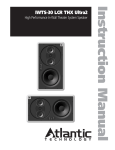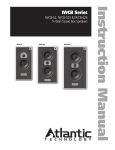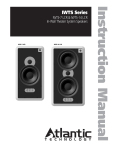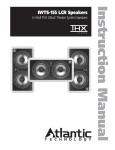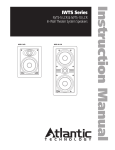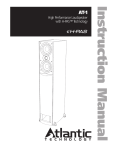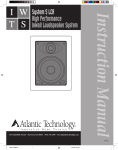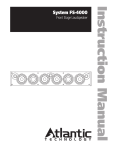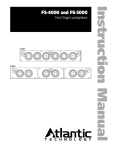Download Atlantic Technology A-2000 Instruction manual
Transcript
In Wall Closed Box Speaker Instruction Manual IWCB-727 THX Select 2 Safety Precautions IWCB-727 THX In-Wall Closed Box Speakers Table of Contents 2 Model IWCB-727 THX 3 Important Considerations Before Installation 3 3 3 Recommended Wire Sizes Location Considerations Room Acoustics 3 4 Stereo Music Listening Home Theater Systems 5 5 6 6 6 6 Removing and Installing the Grille Cutting the Opening Installing the Mounting Frame Painting the Speaker Assembly Speaker Connection and Assembly Installing the Speaker Enclosure Into the Frame 7 7 7 7 HF (High Frequency) Level Control Boundary Compensation Control Directional Vector Control™ IR Knockout 3 Speaker Placement 5 Mounting the IWCB-727 5 Installation of the IWCB-727 in New Construction 5 Installation of the IWCB-727 in Existing Construction 7 Front Panel Controls 7 Specifications Model IWCB-727 THX In Wall Closed Box Speaker Thank you for purchasing Atlantic Technology products. Our speaker systems have been designed to deliver exceptional sound and value. We hope you like what you hear from them, and are happy with your decision to buy them. Please take a few moments to read these instructions. They’re intended not only to tell you how to mount the speakers, but how to get the best performance from them. What’s THX? THX is a series of standards and technologies originally developed by LucasFilm Ltd. (of Star Wars fame) and now an entity unto itself. These technologies and standards are intended to ensure that what you hear and see on your A/V system, as closely as possible, matches what the director/ artist/engineer heard and saw during the final mixing of the source material. THX standards are intended to enhance every type of viewing and listening experience including the latest discrete multi-channel digital formats. Please note however that, although there is proprietary THX electronic processing, THX is not a surround format. THX Select standards (IWCB-727) are based on a 2000 cubic foot room (L x W x H = cu. ft.). This does not mean Select certified components must be used in rooms this exact size. The room sizes simply provide a frame of reference, as the standards specify that the system must deliver certain performance minimums (volume, frequency response, etc.) in the specified space. For more information, see the THX website at www.thx.com. For Future Reference Record your serial numbers and date of purchase here: Model Number Serial Number Date of Purchase The serial number is found on the back panel. Copyright © 2007 Atlantic Technology International. Specifications are those in effect at the time of printing. Atlantic Technology reserves the right to change specifications or designs at any time without notice. Speaker Placement Instruction Manual Important Considerations Before Installation Recommended Wire Sizes The longer the wire run, the heavier the wire should be. Use the following recommendations as a guide for your installation. And if you’re in doubt, remember that it never hurts to get the next heavier grade of wire. Also note that lower gauge numbers equal heavier wire sizes. 3 Speaker Placement For all the following situations, it’s recommended that you first place small box speakers in the proposed locations, just to get a good idea of how that location will sound. In-wall speakers are tough to move once they’re installed! Important: Using Atlantic’s Exclusive Directional Vector Control™ (see Page 7 for more details) Wire Run Wire Gauge: <15 ft. 16 ga. 15 to 30 ft. 14 ga. >30 to 50 ft. 12 ga. Location Considerations A major determinant of any speaker’s sound quality is its location in the room. With in-wall speakers there are fewer placement options than with free-standing speakers, so giving some thought to location can really pay off. Our In-Wall Closed Box systems have been designed to minimize the detrimental effects wall mounting can have on sound, so they sound better than conventional open-back in-wall speakers. DVC Off Room Acoustics Hard surfaces create lots of sound reflections in the room while soft surfaces tend to absorb sound. Note the speakers’ location in terms of proximity to glass and other highly sound reflective or absorptive surfaces. A simple set of curtains or an area rug can make a major difference in sound quality and intelligibility by reducing excessive reflections. DVC On For all the following placement instructions, it’s important to bear in mind that for aesthetic considerations, many people prefer to mount their in-wall speakers well above seated ear level, as doing so minimizes the speakers’ visual intrusion on the room. In those cases, simply engage the DVC “on” and the midrange output of the speakers—which determines both intelligibility and localizability—is directed down towards the listener’s ears, even though the speakers are mounted high up on the walls. For those situations where localizability is not desired, such as background music (sometimes called “whole-house audio”) or surround channel use, leave the DVC “off.” Stereo Music Listening For stereo music reproduction, place the speakers at approximately ear level when seated, with both speakers on the same wall facing the prime listening location. A separation of approximately 6 to 8 feet between the left and right speakers is usually good. Ideally, the distance between the two speakers will be close to the same as the distance from the speakers to the listening position. 4 Home Theater Placement IWCB-727 THX In-Wall Closed Box Speakers Home Theater Systems Front Speaker Array should be placed as close to ear level as possible. Left Center Optional Dipole/Bipole Speakers should be placed directly to the sides of the seating area and approximately 1-2 feet (.3-.6 meter) above the listener’s ear level. Right Subwoofer Optional Direct Radiator Speakers should be placed slightly behind the listening position, above ear level. Optional Surround Back Speakers should be placed approximately 1-2 feet (.3-.6 meter) above the listener’s ear level. Direct radiator or dipole/bipole speakers may be used here. Today’s home theater systems require you to place six or more speakers in your room. For the most convincing theater effects, speaker placement must be very carefully thought out. This is especially true with in-wall speakers, since their installation is permanent! Left/Center/Right Locations The front three speakers should be at or just above ear height when seated, just as with stereo speakers. Try to keep the vertical position of the three front speakers within 18 inches of each other, as this will maintain smooth, believable left-center-right pans. The spacing of the left-right speakers can be a little wider than with 2-channel stereo speakers, since in a theater system, the center channel speaker reproduces the on-screen effects and anchors the center image. Left-right spacing of about 8 to 10 feet usually works well. Surround Speakers In order to achieve optimum performance we strongly recommend Atlantic Technology Dipole or TriVector™ surround speakers. If you are using our dedicated surround speakers please follow the placement recommendations included in their installation instructions. Non-Dipole Surrounds The most realistic surround effects occur when the listener can’t localize the actual location of the surround speaker. If you decide to use the In-Wall Close Box speakers as surround speakers, mount them above the listeners’ ears, slightly behind the listening area either on the side or rear walls. Make sure the DVC is in the “off” position. NOTE: The IWCB-727 is not magnetically shielded. If you are using them with an old CRT-type television, be sure they are at least 12 inches away from the picture tube to prevent video interference. Installation Instruction Manual Mounting the IWCB-727 NOTE: We always recommend a professional be involved in the installation of IWCB speakers. The IWCB-727 speaker can be easily mounted in most any standard wall material, from ½ to 1½ inches thick. Its rotating wall clamps firmly fix it to the wall surface after the proper cutout has been made. Here are some important precautions to take before mounting: Keep the sides of the actual mounting hole at least ½ inch away from beams or studs to ensure that the clamps have adequate room to rotate. A stud or other obstruction that’s too close will stop them from properly doing their job. 5 Installation of the IWCB-727 in Existing Construction Removing and Installing the Grille Remove the grille from the speaker using an awl or the point of a drywall screw in a grille opening near one of the grille corners. Slowly pry the grille out, being careful not to damage the speaker’s frame or its finish. To re-install the grille later, press it carefully into the appropriate opening in the frame assembly. Since it’s designed to fit snugly, please take your time and use care when installing the grille. Cutting the Opening Installation of the IWCB-727 in New Construction Atlantic Technology offers an optional Rough-in Frame Kit to ease installation in new construction. Instructions for its use are included with that kit. 20 3⁄8” (518mm) 11 1⁄8” (283mm) IWCB-626/727 Mounting Template Mount frame as shown, with IR knockout in upper-right corner. Remove scrim before painting grille. After determining the best location for the speaker as outlined above, use the enclosed template to cut the proper size hole. IWCB-727 11 1⁄8” x 20 3⁄8” WARNING: Exercise extreme care before making any wall cuts to ensure that you will not cut through any wires, pipes, or other items that may be in the wall. You may sometimes, but not always, be able to determine the approximate location of wires and pipes by looking at the locations of nearby outlets and plumbing. But their location or absence is never an assurance that there is not something within the wall cavity. 6 Installation IWCB-727 THX In-Wall Closed Box Speakers Installing the Mounting Frame Speaker Connection and Assembly The clamping mechanism allows the wall material to range from ½ to 1½ inches (13 to 38 mm) in thickness. There must be a minimum depth behind the wall face of 3 5⁄8” (92 mm). As noted above, be sure to keep the edges of the cutout at least ½ inch (13 mm) away from any stud or obstruction, as the rotating clamps will not operate properly if you don’t. The speaker enclosure (the black box with the drivers mounted in it) is designed to mount into the white frame, after the frame is mounted into the wall. Insert the frame into the cutout and using a level or square carefully align it so it is level. Tighten the mounting screws, which will cause the attached clamps to rotate and position themselves properly behind the wall. Strip about ½” (13 mm) of insulation from the connecting wires. Connect them to the appropriate push terminal, being careful to observe polarity (positive to the red terminal, negative to the black terminal). Continue to tighten until the frame is snug in the wall. You want the bezel to conform to the wallboard, and the frame not to rattle from the speaker’s vibration, but be very careful not to overtighten the screws. Installing the Speaker Enclosure into the Frame Painting the Speaker Assembly The white plastic frame and the metal grille may be left as is, or painted to match your décor. You can paint the frame before or after it is installed in the wall. Spray painting (using slightly thinned paint) is the best method to use for painting the grille. Before painting, carefully peel off the scrim cloth from inside the grille. After painting the grille, use air pressure to “blow out” any grille holes that are filled in with paint, then carefully replace the scrimcloth. Once the frame is mounted in the wall, the speaker enclosure simply fits into the frame. Note that there is a foam anti-vibration pad affixed to the rear panel of the enclosure. This pad will eliminate any slight vibrations that occur if the back of the speaker enclosure contacts the wallboard in the wall cavity. Due to the usual slight dimensional variances in home construction, the IWCB either may or may not contact the wall surface behind it. Use the included screws to attach the enclosure to the mounting frame, but be very careful not to overtighten the screws. Front Panel Controls Instruction Manual Front Panel Controls The IWCB speakers have three controls that help optimize the speaker’s performance regardless of mounting location or room acoustics. If it’s necessary to mount the speaker closer than 12 inches to the ceiling or corner, you may find that by switching the Boundary Compensation control “on,” the speaker sounds better. We recommend that you try the control in both positions and see if it helps in your particular installation. Directional Vector Control™ Oftentimes, it is visually advantageous to mount the speaker high up on the wall, as this puts the speaker above the field of vision and thus prevents any intrusion by the speaker into the room’s décor. HF (High Frequency) Level Control This control adjusts the relative level of high frequency output to compensate for varying room acoustics or placement behind a screen. “THX” is for absorptive, acoustically “dead” rooms (or when the speaker is behind a movie screen). Use this position to increase the HF level and restore the proper sparkle and liveliness to the sound. “0” is for rooms of average absorptive characteristics. “-“ should be used in rooms that are highly reflective, with hard floors and exposed windows. The setting of the HF control is mostly a matter of personal taste, so try it in all three positions and see which one is preferred. Boundary Compensation Control Large room boundaries, such as floors, walls, and ceilings, reinforce sound by acting essentially as acoustic “mirrors.” When the speaker is mounted too close to the corner or a wall/ceiling intersection, this sonic “reinforcement” often results in an unnatural heaviness or coloration of the sound. Specifications Type Drivers IWCB-727 2½-way M-T-M array Woofer (2) 6 ½” (165mm) GLH* Tweeter 1" (25mm) LRT™ soft dome Frequency Response 75Hz – 20kHz ±3dB Nominal Impedance 6 Ohms Crossover Frequency 800Hz, 2.2kHz Sensitivity 89dB Recommended Power 10 – 140 Watts RMS Dimensions (W x H x D) 12 5⁄16 x 21 5⁄8 x 3 7⁄8" 312 x 547 x 100mm Cutout Dimensions (W x H x D) 11 1⁄8 x 20 3⁄8” 283 x 518mm Net Weight 13lbs; 5.9kg each *Graphite Loaded Homopolymer Specifications are those in effect at the time of printing. Atlantic Technology reserves the right to change specifications or appearance at any time without notice. Dolby Digital, 5.1, Dolby Stereo and Dolby Pro Logic are trademarks of Dolby Laboratories Licensing Corporation. DTS is a registered trademark of DTS Technology. Manufactured under license from THX Ltd. THX is a trademark of THX Ltd. which may be registered in some jurisdictions. All rights reserved. 7 However, acoustically, the best location for a speaker is at seated ear level, about 3-4 feet off the floor. The DVC electronically directs the midrange sound at the listener’s ears, even when the speaker is mounted high up on the wall. The “on” position directs the sound down at the listeners when using the speakers as LCR theater speakers or primary stereo music speakers. The “off” position fires the sound straight out from the speakers—above the listener’s heads—which is perfect for non-localizable surround use, or for room-filling background music (“whole house audio”) use. IR Knockout There’s an IR “knockout” plug in the upper right corner of the front baffle. If you are using a multi-room control system, you can install a standard IR receiver in the knockout hole. Should you have any questions or problems please feel free to contact us at 781-762-6300 or through our web site, www.atlantictechnology.com. 343 Vanderbilt Avenue Norwood, MA 02062 (781) 762-6300 www.atlantictechnology.com 015-1001








